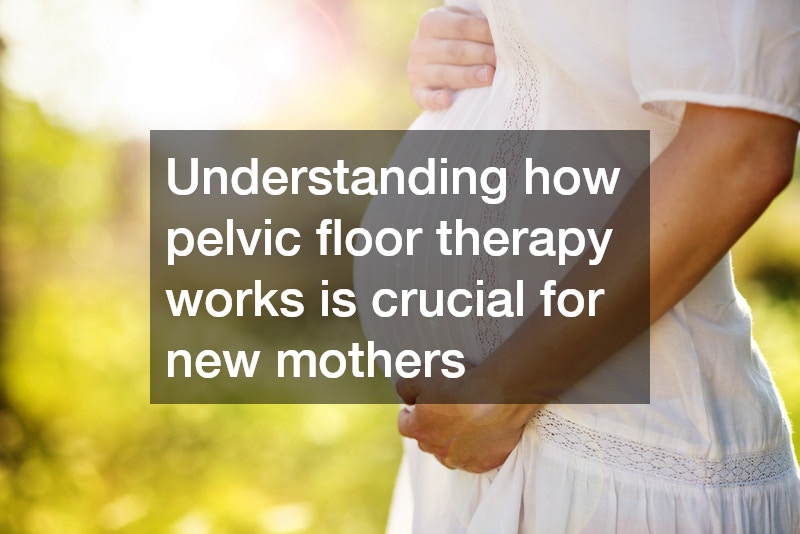It’s critical to understand the importance of pelvic floor therapy for women after childbirth. This therapy can aid in recovery and improve overall well-being.
Defining Pelvic Floor Therapy
Pelvic floor therapy is a specialized form of rehabilitation that targets the pelvic floor muscles, which support the bladder, bowel, and uterus. It is particularly important for women during the postpartum period due to the physical changes that occur during pregnancy and childbirth.
These muscles can become weakened or injured, leading to various complications.
Understanding how pelvic floor therapy works is crucial for new mothers. The therapy involves exercises and techniques aimed at strengthening these muscles, improving their function, and enhancing overall pelvic health. This can have a significant impact on a woman’s recovery journey after giving birth.
The significance of pelvic floor therapy extends beyond just immediate recovery. It can help prevent long-term complications and issues such as pelvic organ prolapse, urinary incontinence, and chronic pelvic pain. Recognizing the importance of addressing pelvic health is a key step in the postpartum recovery process.
How Pelvic Floor Therapy Improves Postpartum Recovery
Pelvic floor therapy can greatly enhance the recovery process by providing women with targeted exercises that strengthen and restore muscle function. These exercises help improve circulation and promote healing in the pelvic region, allowing women to regain strength and confidence in their bodies. As the muscles regain strength, many women notice an improvement in involuntary leakage and overall pelvic stability.
Moreover, pelvic floor therapy can address the hormonal changes experienced during the postpartum period. Therapy can facilitate better body awareness, helping women reconnect with their bodies and understand the changes taking place. This is essential for fostering a healthy mindset and emotional well-being.
Therapists often utilize techniques such as biofeedback and manual therapy, which enhance the therapeutic outcomes. By using these methods, women can experience reduced pain and discomfort and improve their overall quality of life. Such improvements can significantly boost mental health, creating a positive feedback loop in a new mother’s recovery.
Common Conditions Treated with Pelvic Floor Therapy
One of the most common conditions that pelvic floor therapy addresses is postpartum incontinence. Many women experience leakage during activities such as coughing, sneezing, or exercising. Pelvic floor therapy provides tailored exercises to strengthen the pelvic muscles, thus reducing or eliminating these symptoms over time.
In addition to incontinence, pelvic pain is another frequent issue new mothers face. The trauma of childbirth can lead to muscle tension and discomfort in the pelvic region. Pelvic floor therapy can help alleviate this pain through targeted stretching and strengthening exercises. It enables mothers to regain control over their bodies and minimize pain effectively.
Lastly, pelvic floor therapy can help treat pelvic organ prolapse, a condition where pelvic organs slip from their normal position. Therapy often focuses on restoring muscle strength and coordination, which can prevent further complications. Addressing these conditions not only improves physical health but also enhances day-to-day activities and emotional well-being.
How to Find a Qualified Pelvic Floor Therapist
Finding a qualified pelvic floor therapist can seem daunting for new mothers. It is essential to seek professionals who have specialized training in pelvic health. Most qualified therapists are certified and have completed advanced coursework in the field. Searching online directories and websites dedicated to pelvic health can help identify local experts in this area.
Moreover, asking for referrals from healthcare providers or other mothers can lead to trustworthy recommendations. Many obstetricians and gynecologists understand the value of pelvic floor therapy and can provide suggestions based on personal experiences or trusted colleagues. Community groups for new mothers can also serve as excellent resources.
It is essential to consider the therapist’s approach, experience, and comfort level during the initial consultation. A good therapist will take the time to discuss individual needs, concerns, and goals, ensuring a personalized experience. Feeling comfortable and understood during the therapy journey significantly impacts recovery outcomes.
What to Expect During a Pelvic Floor Therapy Session
This section will outline the typical process of a therapy session, including exercises and techniques used.
During a typical pelvic floor therapy session, the therapist will first conduct a thorough assessment, evaluating the pelvic floor’s strength and function. This assessment may involve physical examinations and discussions about symptoms and experiences related to childbirth. The goal is to gather information to tailor the therapy specifically for the individual.
The session will likely include various exercises designed to strengthen, relax, and coordinate the pelvic floor muscles. Therapists often incorporate techniques such as Kegel exercises, which focus on contracting and relaxing the pelvic muscles. These exercises can be adapted to meet specific recovery goals and individual fitness levels.
In addition to exercises, some sessions may involve biofeedback, manual therapy, or education regarding posture and body mechanics. Understanding how to engage the pelvic floor correctly during daily activities is crucial for effective rehabilitation. The objective is to provide women with practical tools they can integrate into their lives, fostering lasting health benefits.
Pelvic floor therapy can play a vital role in helping women recover after childbirth. Understanding its benefits and processes empowers new mothers to prioritize their health and well-being.




